7 MIN READ
Cotton Growth and Development
February 14, 2024
- Growth is an irreversible increase in size and mass.
- Development is the progression through defined phases.
- Cotton has a complex plant structure, which can make it a very challenging crop to manage.
- Cotton plants follow a set pattern of growth and development, according to accumulated heat units known as degree day 60s (DD60s). However, sensitivity to varying environmental conditions can also affect the plants’ development.
- Understanding cotton growth and development can help build a foundation for crop management.
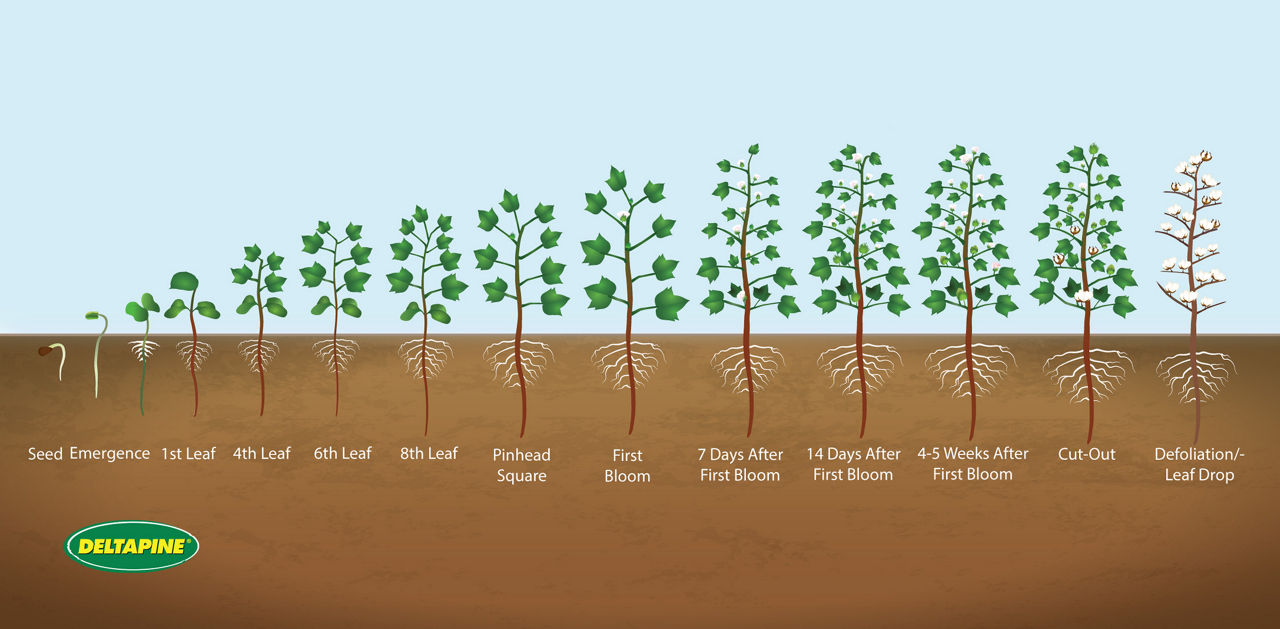
Calculating Heat Units
Degree day 60s, or DD60s, are units of heat accumulation used in calculating the growth stage of cotton plants. Cotton growth and development progression can be characterized by the number of days since planting or emergence, but growth progression varies according to temperature. Monitoring cotton heat unit accumulation is useful for determining a more accurate estimation of a plant’s growth stage. Cotton plants have little to no development below 60 °F, so DD60s first average the difference in the daily maximum temperature and daily minimum temperature and then subtract 60 in order to calculate the daily accumulated DD60s, as represented in the formula: 1
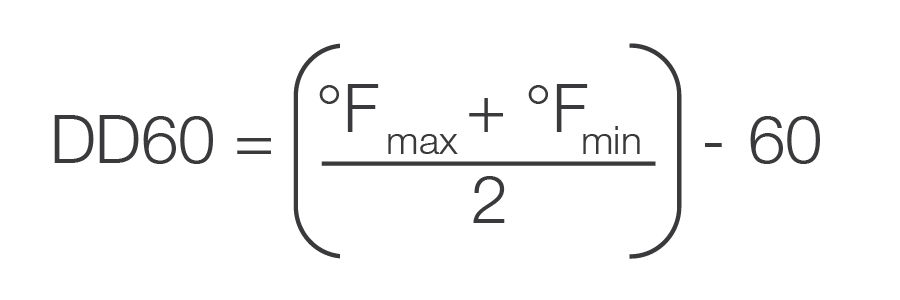
Calculating the total accumulation of DD60s can help determine the growth stage of a cotton crop (Table 1). Online DD60 calculators may be available from your state extension. The number of DD60s required to achieve a growth stage will vary based on cotton variety. Earlier-maturing cotton varieties require fewer DD60s than later-maturing varieties to reach maturity.
Table 1. Estimated cotton growth stages from planting indicated by the accumulation of days and DD60s.

Emergence and Stand Establishment
Emergence typically occurs 4 to 9 days after planting, or after the accumulation of 50 DD60s.2 Seedling establishment is complete once the cotyledons emerge through the soil and unfold to expose the hypocotyl and apical meristem.
To help optimize cotton stand establishment, consider the following:
- Use a high-quality seed (standard warm germination test results of at least 80%).
- Plant when there is a favorable degree-day forecast for the five days post planting, with an expected heat unit accumulation of approximately 25 to 50 DD60s.
- The soil at planting depth should be warm and moist. By mid-morning, the soil temperature should be at least 68 °F at the desired planting depth for three consecutive days.3
- Seed should be planted 0.5 to 1.5 inches deep, depending on the soil texture and moisture. Shallow planting can result in poor seed-to-soil contact and deep planting can delay emergence and cause skippy stands. Confirm seed depth by digging up seeds after planting 50 to 100 ft of row.
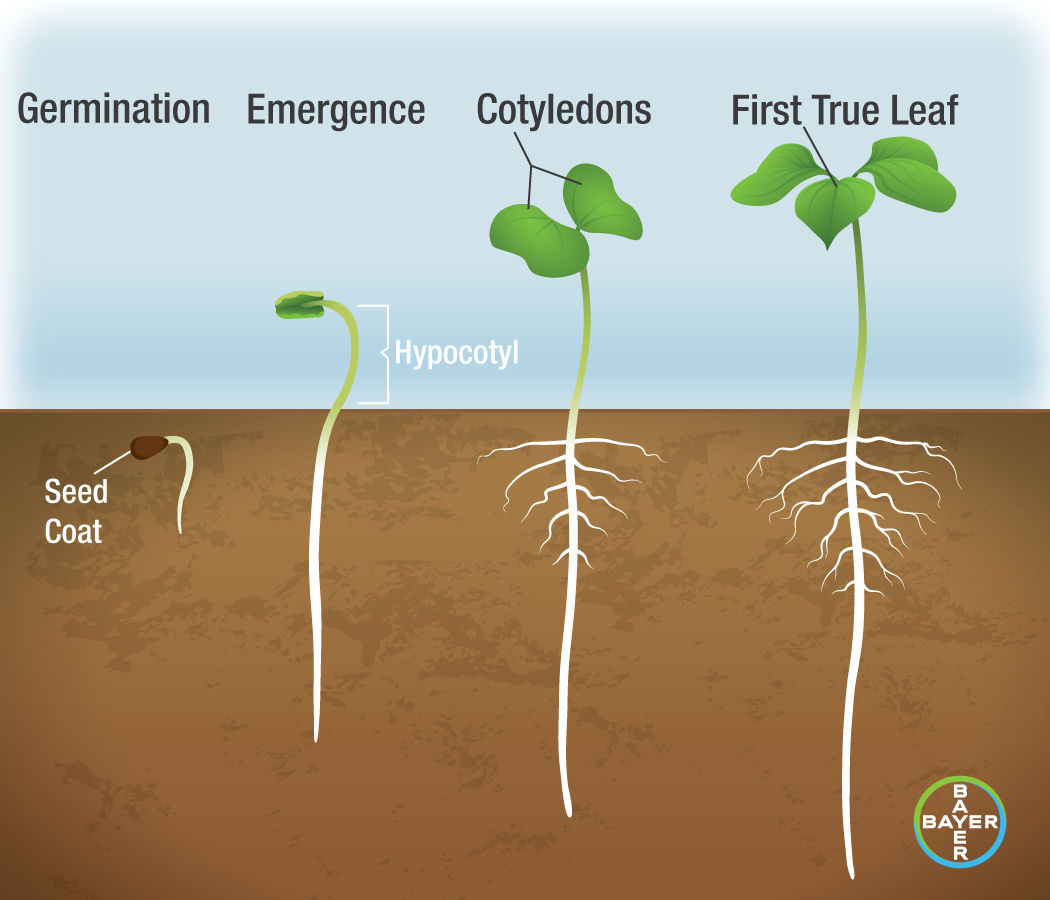
Early Vegetative Growth
Vegetative growth is categorized by the development of leaves, nodes, and roots. Cotton has an indeterminate growth habit, allowing plants to grow very tall and heavy with vegetation if they are not managed properly.
First true leaf. Emerges about 50 DD60s (or in four to nine days) after seedling establishment, shifting the plant’s energy source from cotyledons to the first emerging leaf.
Nodes. Points of attachment where leaves and branches form (Figure 2). A new node is produced by the apical meristem approximately every three days.
Leaves. Leaves produced from the main stem are called main-stem leaves and leaves located on fruiting branches are called subtending leaves (Figure 3). Main stem leaves are the first structures to appear on the main stem.
Roots. Cotton plants produce a taproot that can be 10 inches deep by the time the first true leaf is formed. Roots grow around 0.5 to 2 inches per day during early vegetative growth and slow substantially once bolls are set, as the plant directs carbohydrates away from root development to boll development.4
Branch Development
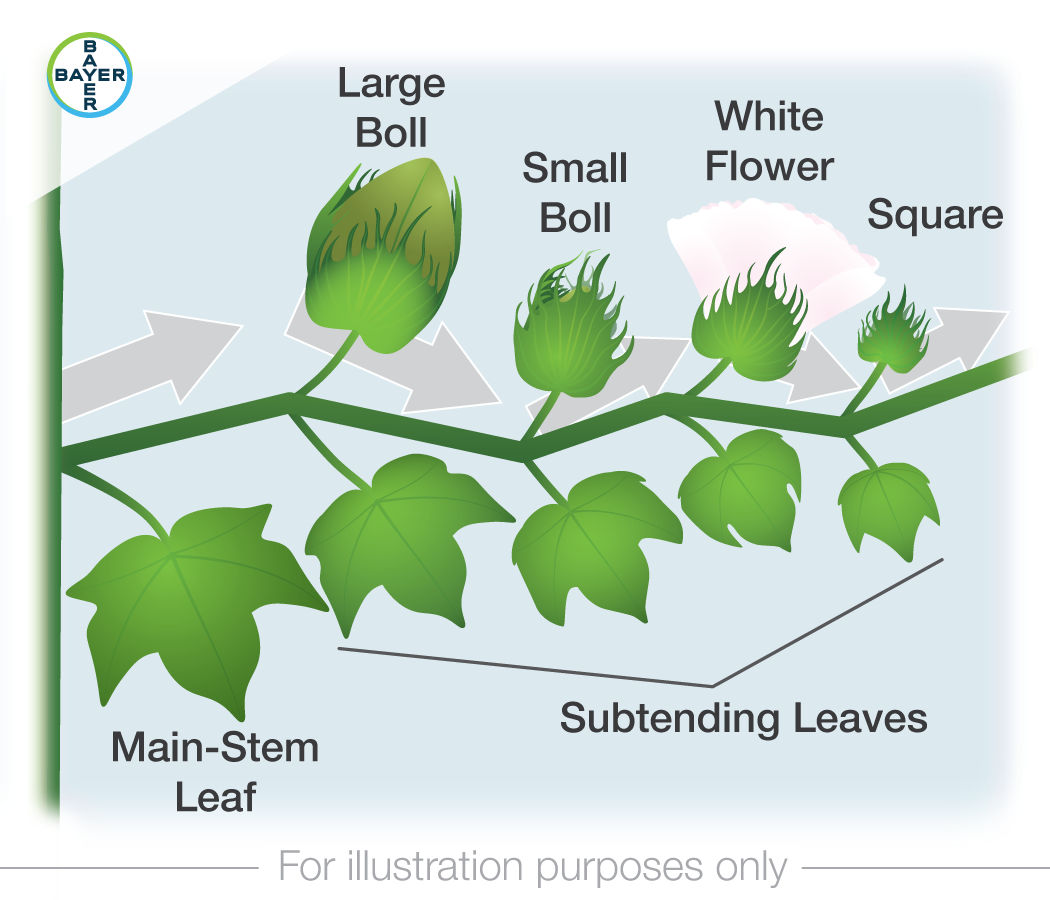
Cotton plants develop two types of branches: vegetative and fruiting.
Vegetative branches. Straight-growing branches intended for producing energy through photosynthesis. Mainstem and other vegetative branches typically form on lower nodes.
Fruiting branches. Branches that grow in a zigzag pattern, with multiple meristems that form fruiting buds. The first fruiting branch typically forms at mainstem node 5 or 6. New fruiting branches develop about every three days and squares form at new positions on fruiting branches every six days.
Reproductive Growth
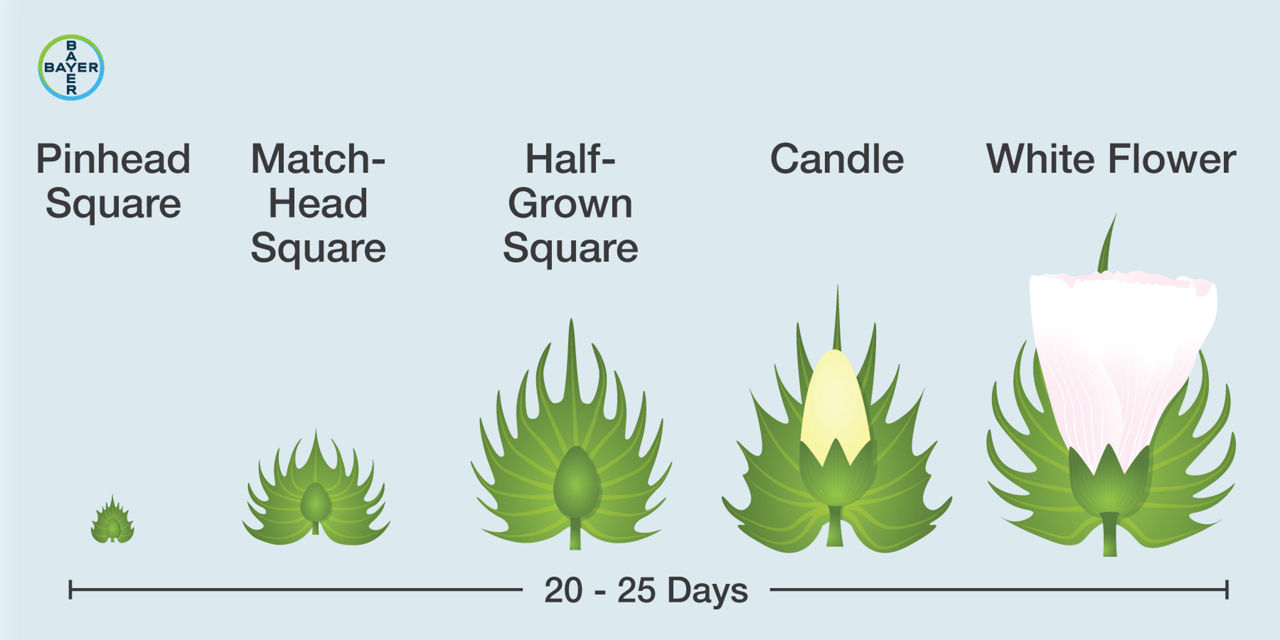
Reproductive growth is characterized by square development and node location on the plant.
Square development. The square (pre-bloom flower bud) forms when the fruiting branch forms.
First square position. This is the location where the first square is produced. As a square develops, the section of the branch between the main stem and square elongates, and an axillary meristem also develops on the branch adjacent to the square. The auxiliary meristem will produce a second position square and a subtending leaf. The first square typically forms on nodes 5 to 7.
Cotton bud formation. There are several development stages of a cotton bud (Figure 4). The white bloom stage occurs three to four weeks after the pinhead square stage.
Pinhead square. The first stage at which the square can be identified.
Match-head square. The bud is one third of its full size.
Candle. Occurs just prior to bloom. The bud is shaped like a candle.
White flower. Occurs once the bud blooms. The flowering period typically lasts four to six weeks and is characterized in terms of weeks of bloom. When a bloom first opens, the flower is white, and pollination may occur within hours of opening. By the next day, the flower has a pink tint, and turns dark pink the following day. Within the week, the flower dries up and falls off the plant, exposing a fertilized boll. During early bloom, the mainstem continues to grow and add new leaves, nodes, and squares. As more bolls are set, the plant’s energy is diverted from vegetative growth to boll formation.
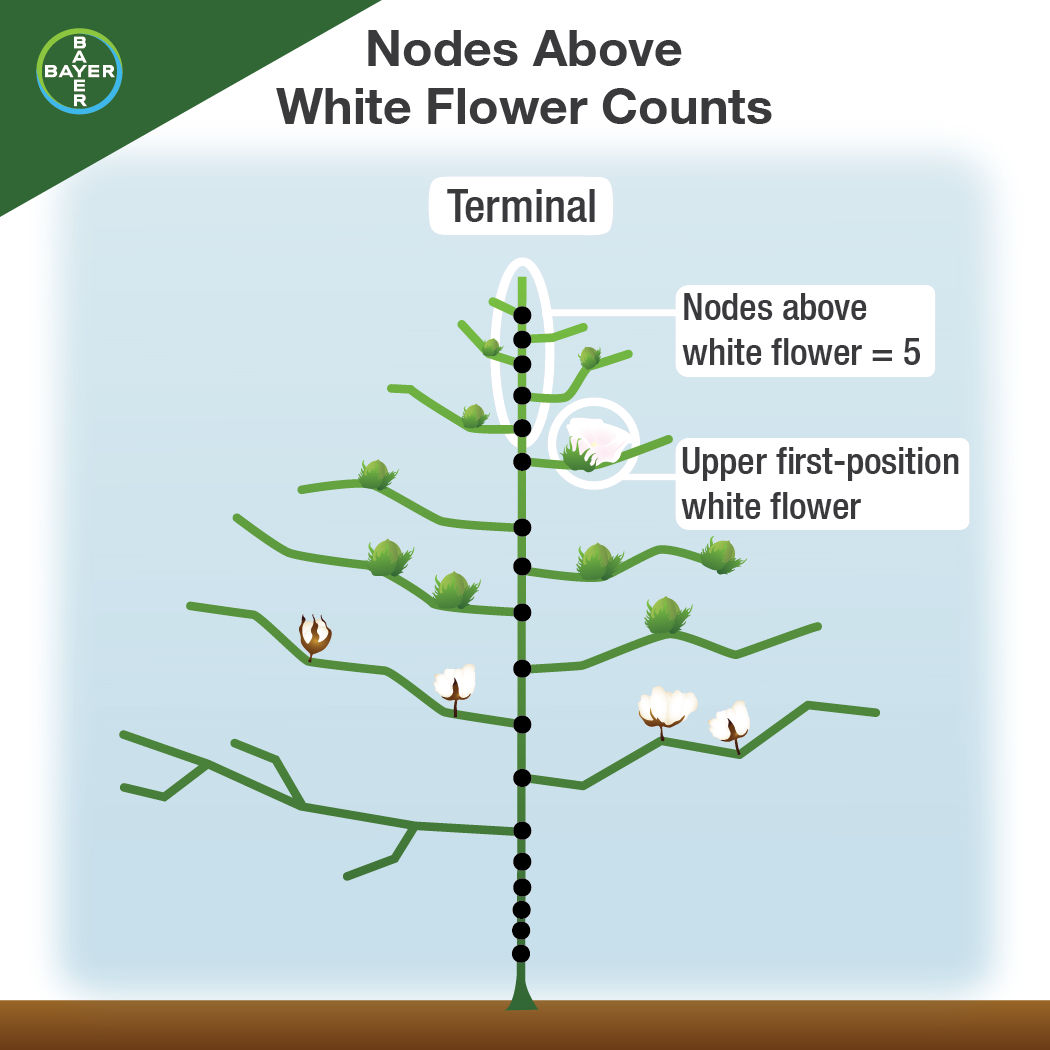
Nodes above white flower (NAWF). During flowering, cotton plant development may also be categorized in terms of NAWF. This measurement is taken by the number of nodes separating the uppermost first position bloom and the terminal of the plant. At first bloom, a plant may have 9 or 10 NAWF, and the number decreases as blooms continue to form up the plant. Flower development will eventually slow, and cutout occurs at around 4 or 5 NAWF, when no more harvestable bolls are set on the plant (Figure 5).
Boll Production
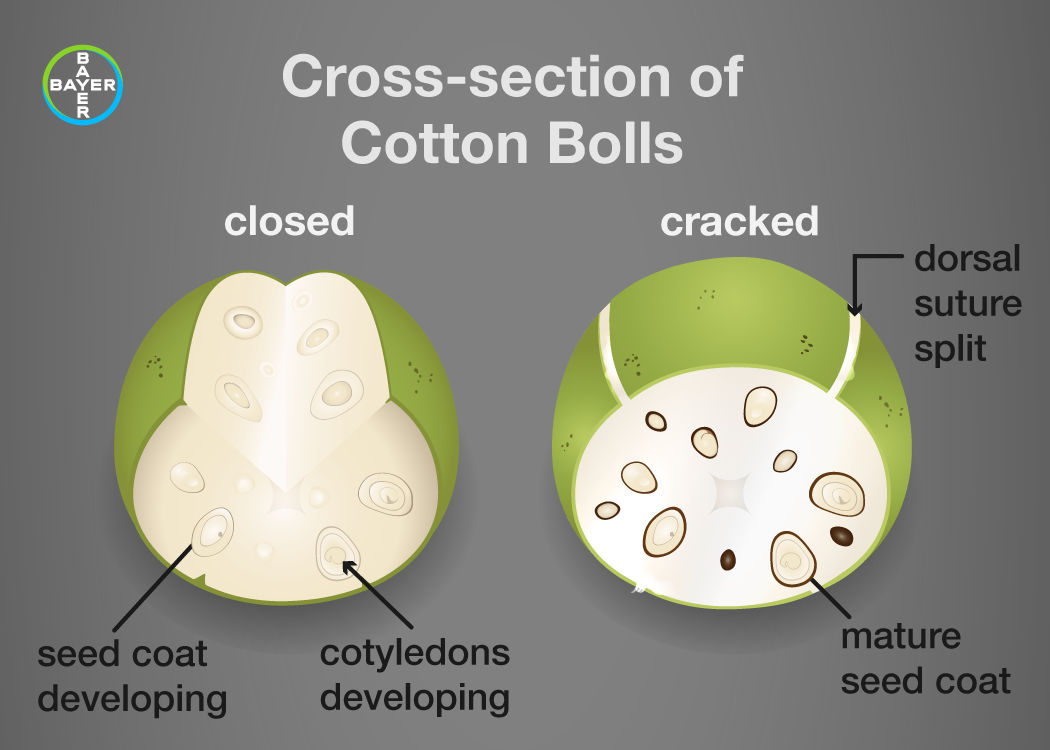
A boll can open in about 50 days with optimum growing conditions. Cotton fibers are very sensitive to environmental conditions during boll development. The three phases of boll development are as follows:
Enlargement. The fibers produced on the seed begin to elongate and the maximum volume of the boll and seeds are set. During this stage, the fibers during are a thin-walled tubular structure. This phase typically lasts three weeks.
Filling. The filling phase begins during the fourth week after flowering and will continue for two weeks. The secondary walls of the cotton fiber will form, a process known as deposition, and oil and proteins form in the seeds.
Maturation. This phase begins when the boll reaches full size and maximum weight. The fiber and seeds within the boll mature and boll dehiscence occurs. The walls of the boll dry and split, opening the boll.
Nutrient Demand
As a cotton plant grows, the demand for carbohydrates and nutrients increases. Earlier in the season, the plant sends all resources into vegetative and root growth. As the season progresses into reproductive growth, the plant prioritizes using resources for fruit production while continuing to support vegetative growth. Early cutout may occur if there are not enough nutrients to support both reproductive and vegetative growth. Plants may shed squares and small bolls to preserve larger bolls if the nutrient supply is low. This occurs more often after environmental stress—cloudy weather, high temperatures, moisture stress, or leaf damage during flowering. The reduced photosynthesis lowers carbohydrate production, resulting in square shed.4
Sources
1 Growth and development of a cotton plant. National Cotton Council and The Cotton Foundation. Advancing Cotton Education. https://www.cotton.org/tech/ace/growth-and-development.cfm/.
2 Ritchie, G.L., Bednarz, C.W., Jost, P.H., and Brown, S.M. 2007. Cotton growth and development. The University of Georgia Cooperative Extension Service. Bulletin 1252. https://esploro.libs.uga.edu/esploro/outputs/report/Cotton-growth-and-development/9949316286902959
3 Main, C. L. 2012. Cotton production in Tennessee. University of Tennessee Extension. W288. https://trace.tennessee.edu/utk_agexcrop/156/
4 Albers, D.W. 2023. Cotton plant development and plant mapping. Wilson, B. (Ed.) University of Missouri Extension. https://extension.missouri.edu/publications/g4268.
1414_229452